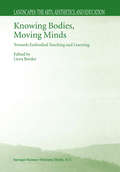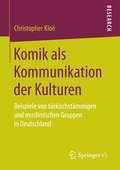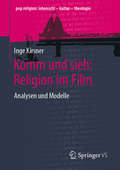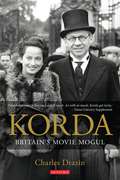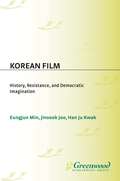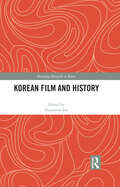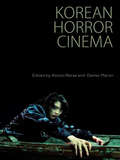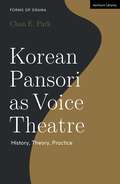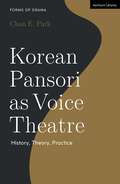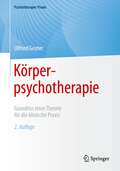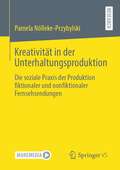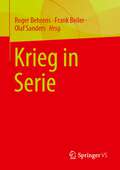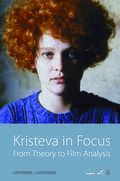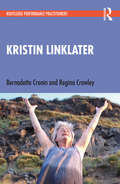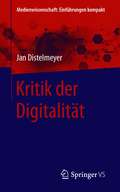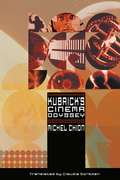- Table View
- List View
Knights of Cinema: The Story of the Palestine Film Unit (Palgrave Studies in Arab Cinema)
by Khadijeh HabashnehThis book consists of an account of the creation of the Palestine Film Unit (PFU) and its founding members, from the photography department in the early years of the Palestinian revolution (1967-1968), to its evolution in the mid-1970’s into the Palestinian Cinema Institution. Khadijeh Habashneh weaves her own memories into excerpts from letters and other communications of survivors, friends and PFU family members, with writings by scholars who analyzed the work and the contributions of this remarkable film movement (from the late 1960’s to early 1980’s). As such it offers a unique perspective on this aspect of Palestine film history that ended in the loss of its archive in the mid 1980’s, providing details that have not been previously published in English.
Knowing Bodies, Moving Minds: Towards Embodied Teaching and Learning (Landscapes: the Arts, Aesthetics, and Education #3)
by Liora BreslerThis book aims to define new theoretical, practical, and methodological directions in educational research centered on the role of the body in teaching and learning. Based on our phenomenological experience of the world, it draws on perspectives from arts-education and aesthetics, as well as curriculum theory, cultural anthropology and ethnomusicology. These are arenas with a rich untapped cache of experience and inquiry that can be applied to the notions of schooling, teaching and learning. The book provides examples of state-of-the-art, empirical research on the body in a variety of educational settings. Diverse art forms, curricular settings, educational levels, and cultural traditions are selected to demonstrate the complexity and richness of embodied knowledge as they are manifested through institutional structures, disciplines, and specific practices.
Komik als Kommunikation der Kulturen: Beispiele von türkischstämmigen und muslimischen Gruppen in Deutschland
by Christopher KloëChristopher Kloë stellt in diesem Buch Samuel Huntingtons Hypothese eines Kampfes der Kulturen die Systematik einer Begegnung der Kulturen gegenüber. Diese wird durch das Mittel der medialen komischen Kommunikation von (Selbst-)Darstellungen anhand der Thesen von Homi K. Bhabha, Thilo Sarrazin, Alfred Schütz und Zygmunt Bauman erläutert. Der Vorgang einer ansteigenden Auseinandersetzung mit den jeweils Fremden auch in der Form von komischen Inszenierungen, die als analog zum ansteigenden Eintritt von Fremden in den lokalen sozialen Raum betrachtet wird, erläutert der Autor am Beispiel von türkischstämmigen und muslimischen Gruppen in Deutschland und im Vergleich zu Minderheiten im westlichen Kulturkreis.
Komm und sieh: Analysen und Modelle (pop.religion: lebensstil – kultur – theologie)
by Inge KirsnerDer erste große Teil dieses Bandes beschreibt – angefangen bei den „Zehn Geboten“ und ihrer Aktualisierung in „The Beach“ über das „Opfer“ Harry Potters, Blade Runners & Katniss´ in „Tribute von Panem" bis hin zu natürlichen und künstlichen Intelligenzen ("Planet der Affen" und "Ex Machina") – wie Religion in aktuellen Filmen thematisiert wird, die sich u. a. mit den Folgen der Digitalisierung und Mechanisierung sowie deren Auswirkungen auf das Menschenbild der Zukunft beschäftigen. Im zweiten Teil finden diese Themen praktisch-theologisch und liturgisch Gestalt, nämlich in Form von Filmgottesdiensten, die als Bausteine für Deutsch- und Religionsunterricht und für Gottesdienste in Schulen, Gemeinden und in der Erwachsenenbildung dienen können.
Konstantin Stanislavsky (Routledge Performance Practitioners)
by Bella MerlinAs one of the most well-known names in theatre history, Konstantin Stanislavsky’s teachings on actor training have endured throughout the decades, influencing scholars and practitioners even in the present day. This second edition of Konstantin Stanislavsky combines: an overview of Stanislavsky’s life and work, including recent discoveries an assessment of his widely read text, An Actor Prepares (1936) with comparisons to Benedetti’s 2008 translation, An Actor’s Work detailed commentary of the key 1898 production of The Seagull an indispensable set of practical exercises for actors, teachers and directors. As a first step towards critical understanding, and as an initial ex- ploration before going on to further, primary research, Routledge Performance Practitioners are unbeatable value for today’s student.
Konstantin Stanislavsky (Routledge Performance Practitioners)
by Bella MerlinAs one of the most well-known names in theatre history, Konstantin Stanislavsky’s teachings on actor training have endured throughout the decades, influencing scholars and practitioners even in the present day. This second edition of Konstantin Stanislavsky combines: an overview of Stanislavsky’s life and work, including recent discoveries an assessment of his widely read text, An Actor Prepares (1936) with comparisons to Benedetti’s 2008 translation, An Actor’s Work detailed commentary of the key 1898 production of The Seagull an indispensable set of practical exercises for actors, teachers and directors. As a first step towards critical understanding, and as an initial ex- ploration before going on to further, primary research, Routledge Performance Practitioners are unbeatable value for today’s student.
Korda: Britain's Movie Mogul
by Charles DrazinThe producer behind such celebrated films as The Four Feathers and The Third Man is one of the most colourful and important figures in the history of the British cinema. This gripping biography tells how with extraordinary ambition, enterprise and showmanship, Alexander Korda established in Britain a film industry that rivalled Hollywood, built Europe's biggest studio, and created world-class stars, including Charles Laughton and Vivien Leigh.The biography traces Korda's path from his rural childhood in a remote part of Hungary to a British knighthood. Korda's legacy, it argues, was a film industry that dared to dream on the largest possible scale. But he also exemplified the pattern of boom and bust that dogged the British cinema ever since he first came into the limelight in 1933 with the international success of The Private Life of Henry VIII. To understand his often turbulent career is to gain a profound insight into the nature of the British cinema both then and now.'In this thorough and jaunty biography, Drazin gives us a masterly portrait.' - Sunday Times'An engrossing exegesis of film-making in inter- war Britain and a rounded portrait of what we'd now call an economic migrant who lived profligately, left others poorer and occasionally and enduringly enriched the screen.' - Evening Standard'Wry, ruthless and expertly researched.' - Financial Times
A Korean Approach to Actor Training
by Jeungsook YooA Korean Approach to Actor Training develops a vital, intercultural method of performer training, introducing Korean and more broadly East Asian discourses into contemporary training and acting practice. This volume examines the psychophysical nature of a performer’s creative process, applying Dahnhak, a form of Korean meditation, and its central principle of ki-energy, to the processes and dramaturgies of acting. A practitioner as well as a scholar, Jeungsook Yoo draws upon her own experiences of training and performing, addressing productions including Bald Soprano (2004), Water Station (2004) and Playing ‘The Maids’ (2013–2015). A significant contribution to contemporary acting theory, A Korean Approach to Actor Training provides a fresh outlook on performer training which will be invaluable to scholars and practitioners alike.
A Korean Approach to Actor Training
by Jeungsook YooA Korean Approach to Actor Training develops a vital, intercultural method of performer training, introducing Korean and more broadly East Asian discourses into contemporary training and acting practice. This volume examines the psychophysical nature of a performer’s creative process, applying Dahnhak, a form of Korean meditation, and its central principle of ki-energy, to the processes and dramaturgies of acting. A practitioner as well as a scholar, Jeungsook Yoo draws upon her own experiences of training and performing, addressing productions including Bald Soprano (2004), Water Station (2004) and Playing ‘The Maids’ (2013–2015). A significant contribution to contemporary acting theory, A Korean Approach to Actor Training provides a fresh outlook on performer training which will be invaluable to scholars and practitioners alike.
Korean Film: History, Resistance, and Democratic Imagination (Non-ser.)
by Eungjun Min Jinsook Joo Han Ju KwakDespite its rise in the global market, recent political progress, and a surging interest worldwide, Korean films are relatively unknown and rarely studied. This new work begins by investigating the history, industry structure, and trends of filmmaking in Korea, going on to examine how Hollywood films have affected both Korean mainstream and nonmainstream film industries in terms of both means of production and narrative. Moreover, the authors analyze the ways in which Korean films of recent years have represented the modernization process in Korea itself, as well as the ideological implications that arise from the cinematic constructions of Korean imagination.More than a mere chronological account of Korean cinematic history, ^IKorean Film^R attempts to consider the films as a popular cultural form that have a life beyond their theatrical runs: stars, genres, and key movies become part of any culture's identity, and in their narratives and meanings can be located evidence of the ways in which a culture makes sense of itself. Korea has never before been given such an extensive treatment of this central idea, and here for the first time, the nation's culture and cinema are merged into one discussion that both reflects and shapes our understanding of it.
Korean Film and History (Routledge Research on Korea)
by Hyunseon LeeCinema has become a battleground upon which history is made – a major mass medium of the twentieth century dealing with history. The re-enactments of historical events in film straddle reality and fantasy, documentary and fiction, representation and performance, entertainment and education. This interdisciplinary book examines the relationship between film and history and the links between historical research and filmic (re-)presentations of history with special reference to South Korean cinema. As with all national film industries, Korean cinema functions as a medium of inventing national history, identity, and also establishing their legitimacy – both in forgetting the past and remembering history. Korean films also play a part in forging cultural collective memory. Korea as a colonized and divided nation clearly adopted different approaches to the filmic depiction of history compared to colonial powers such as Western or Japanese cinema. The Colonial Period (1910-45) and Korean War (1950-53) draw particular attention as they have been major topics shaping the narrative of nation in North and South Korean films. Exploring the changing modes, impacts and functions of screen images dealing with history in Korean cinema, this book will be of huge interest to students and scholars of Korean history, film, media and cultural studies.
Korean Film and History (Routledge Research on Korea)
Cinema has become a battleground upon which history is made – a major mass medium of the twentieth century dealing with history. The re-enactments of historical events in film straddle reality and fantasy, documentary and fiction, representation and performance, entertainment and education. This interdisciplinary book examines the relationship between film and history and the links between historical research and filmic (re-)presentations of history with special reference to South Korean cinema. As with all national film industries, Korean cinema functions as a medium of inventing national history, identity, and also establishing their legitimacy – both in forgetting the past and remembering history. Korean films also play a part in forging cultural collective memory. Korea as a colonized and divided nation clearly adopted different approaches to the filmic depiction of history compared to colonial powers such as Western or Japanese cinema. The Colonial Period (1910-45) and Korean War (1950-53) draw particular attention as they have been major topics shaping the narrative of nation in North and South Korean films. Exploring the changing modes, impacts and functions of screen images dealing with history in Korean cinema, this book will be of huge interest to students and scholars of Korean history, film, media and cultural studies.
Korean Horror Cinema
by Alison Peirse Daniel MartinAs the first detailed English-language book on the subject, Korean Horror Cinema introduces the cultural specificity of the genre to an international audience, from the iconic monsters of gothic horror, such as the wonhon (vengeful female ghost) and the gumiho (shapeshifting fox), to the avenging killers of Oldboy and Death Bell. Beginning in the 1960s with The Housemaid, it traces a path through the history of Korean horror, offering new interpretations of classic films, demarcating the shifting patterns of production and consumption across the decades, and introducing readers to films rarely seen and discussed outside of Korea. It explores the importance of folklore and myth on horror film narratives, the impact of political and social change upon the genre, and accounts for the transnational triumph of some of Korea’s contemporary horror films. While covering some of the most successful recent films such as Thirst, A Tale of Two Sisters, and Phone, the collection also explores the obscure, the arcane and the little-known outside Korea, including detailed analyses of The Devil’s Stairway, Woman’s Wail and The Fox With Nine Tails. Its exploration and definition of the canon makes it an engaging and essential read for students and scholars in horror film studies and Korean Studies alike.
Korean Pansori as Voice Theatre: History, Theory, Practice (Forms of Drama)
by Chan E. ParkThis book introduces readers to the historical, performative, and cultural context of pansori, a traditional Korean oral story-singing art. Written by a scholar-practitioner of the form, this study is structured in three parts and begins by introducing readers to the technical, aesthetic, and theoretical components of pansori, as well as the synthesis of vocal and percussive elements that stage the narrative. It moves on to reflect on the historical contexts of pansori, alongside Korea's transformation from Joseon monarchy to modern statehood. It argues that with colonial annexation came modernist influences that Korean dramatists and audiences used to create new genres of performance, using the common thread of pansori. The book's third part explores the interplay of preservation and innovation, beginning in the post-war period and continuing with developments in the 20th and 21st centuries that coincide with Korea's imprint on cultural globalization. Along with Korea's growth as a world economic center, a growing enthusiasm for Korean culture around the world has increased the transmission and visibility of pansori. This study argues that tradition and innovation are not as divergent as they are sometimes imagined to be and that tradition is the force that enables innovation. Drawing on Chan E. Park's ethnographic work and performance practice, this book interweaves expert knowledge of both the textual and performative aspects of pansori, rendering legible this dramatic tradition.
Korean Pansori as Voice Theatre: History, Theory, Practice (Forms of Drama)
by Chan E. ParkThis book introduces readers to the historical, performative, and cultural context of pansori, a traditional Korean oral story-singing art. Written by a scholar-practitioner of the form, this study is structured in three parts and begins by introducing readers to the technical, aesthetic, and theoretical components of pansori, as well as the synthesis of vocal and percussive elements that stage the narrative. It moves on to reflect on the historical contexts of pansori, alongside Korea's transformation from Joseon monarchy to modern statehood. It argues that with colonial annexation came modernist influences that Korean dramatists and audiences used to create new genres of performance, using the common thread of pansori. The book's third part explores the interplay of preservation and innovation, beginning in the post-war period and continuing with developments in the 20th and 21st centuries that coincide with Korea's imprint on cultural globalization. Along with Korea's growth as a world economic center, a growing enthusiasm for Korean culture around the world has increased the transmission and visibility of pansori. This study argues that tradition and innovation are not as divergent as they are sometimes imagined to be and that tradition is the force that enables innovation. Drawing on Chan E. Park's ethnographic work and performance practice, this book interweaves expert knowledge of both the textual and performative aspects of pansori, rendering legible this dramatic tradition.
Körperpsychotherapie: Grundriss einer Theorie für die klinische Praxis (Psychotherapie: Praxis)
by Ulfried GeuterEin einführendes Buch für die psychotherapeutische Praxis: Körperpsychotherapie als Therapie mit Hilfe des Körpers. Geschrieben für Psychologische und Ärztliche Psychotherapeuten, explizite Körpertherapeuten (Atem, Feldenkrais etc.), aber auch viele andere Berufsgruppen, die in diesem Feld tätig sind.
Kreativität in der Unterhaltungsproduktion: Die soziale Praxis der Produktion fiktionaler und nonfiktionaler Fernsehsendungen
by Pamela Nölleke-PrzybylskiKreativität charakterisiert die Fernsehunterhaltungsproduktion. Das vorliegende Buch greift diese Prämisse auf und zeichnet systematisch nach, wie und wo Kreativität im Feld der Fernsehunterhaltungsproduktion tatsächlich eine Rolle spielt – auf der Ebene der Prozesse, der Produkte und der im Feld tätigen Personen. Die Autorin bringt Praxis- und Kreativitätstheorien zusammen und entwickelt auf dieser Basis ein Modell sozialer und spezifisch auch kreativer Praxis im Feld der Unterhaltungsproduktion. Das Modell liefert konkrete Anknüpfungspunkte nicht nur für eine empirische Analyse des Feldes, sondern auch für das Management des Produktionsprozesses.
Krieg in Serie
by Roger Behrens Frank Beiler Olaf SandersDieses Buch thematisiert im Rahmen einer interdisziplinär ausgerichteten TV-Serienforschung Beiträge zum besonderen Format der Kriegsserie. Der Bogen der diskutierten Serien reicht von M*A*S*H aus der Zeit des „klassischen“ Fernsehens bis zu neueren und neusten Produktionen, die über Streaming-Dienste angeboten werden wie zum Beispiel Das Boot oder die Bundeswehr-YouTube-Serien Die Rekruten und Mali. Diskutiert werden Kriegsserien in ihren Überschneidungen mit anderen Film- und TV-Genres (Krimiserie: Magnum, p.i., History-Serie: Vikings, Sciencefiction: Battlestar Galactica, Star Trek, auch Philip K. Dick’s Electric Dreams). Im Focus steht überdies die steigende Bedeutung der Kriegsthematik in Serienproduktionen seit der Jahrtausendwende (im Zusammenhang mit den „neuen Kriegen“) wie Band of Brothers, The Pacific oder Generation Kill. Neben den aktualisierenden Untersuchungen geht es schließlich auch um historische Rekonstruktion, wenn Serien wie Combat! bis Over There untersucht werden.
Kristeva in Focus: From Theory to Film Analysis (Berghahn Ser.)
by Katherine J. GoodnowDealing with some of the major themes in film narratives, this book draws on the theories of French psychoanalyst Julia Kristeva. It looks at how narratives have changed over time, and considers the sources of our variable reactions to themes and representations of horror, strangers, and love. In addition to a selection of contemporary mainstream films, the major films for analysis are New Zealand “New Wave” films such as Alison Maclean’s Kitchen Sink and Crush; Vincent Ward’s Vigil; and Jane Campion’s Sweety, An Angel at My Table, and The Piano.
Kristeva in Focus: From Theory to Film Analysis
by Katherine J. GoodnowDealing with some of the major themes in film narratives, this book draws on the theories of French psychoanalyst Julia Kristeva. It looks at how narratives have changed over time, and considers the sources of our variable reactions to themes and representations of horror, strangers, and love. In addition to a selection of contemporary mainstream films, the major films for analysis are New Zealand “New Wave” films such as Alison Maclean’s Kitchen Sink and Crush; Vincent Ward’s Vigil; and Jane Campion’s Sweety, An Angel at My Table, and The Piano.
Kristin Linklater (Routledge Performance Practitioners)
by Bernadette Cronin Regina CrowleyKristin Linklater is one of the most internationally recognised names in the field of voice training, and this volume explores her work and life whilst also putting her work into practice. Charting the development of Linklater's process, including her work at LAMDA, the Lincoln Centre, NYU, Columbia, and the KLVC on Orkney, the book provides a comprehensive overview of one of the world’s leading voice coaches. This book contains: A detailed biography of Linklater’s life, including her work with Iris Warren at LAMDA, as well as the founding of her own companies and the KLVC on Orkney. Detailed analysis of her key text, Freeing the Natural Voice, and her work with Carol Gilligan on The Company of Women, an all-female Shakespeare company they co-conceived. A comprehensive set of exercises – several of these previously unpublished. This book offers essential reading and an invaluable practice handbook to the contemporary performer, voice teacher, and actor trainer. As a first step towards critical understanding, and as an initial exploration before going on to further, primary research, Routledge Performance Practitioners offer unbeatable value for today’s student.
Kristin Linklater (Routledge Performance Practitioners)
by Bernadette Cronin Regina CrowleyKristin Linklater is one of the most internationally recognised names in the field of voice training, and this volume explores her work and life whilst also putting her work into practice. Charting the development of Linklater's process, including her work at LAMDA, the Lincoln Centre, NYU, Columbia, and the KLVC on Orkney, the book provides a comprehensive overview of one of the world’s leading voice coaches. This book contains: A detailed biography of Linklater’s life, including her work with Iris Warren at LAMDA, as well as the founding of her own companies and the KLVC on Orkney. Detailed analysis of her key text, Freeing the Natural Voice, and her work with Carol Gilligan on The Company of Women, an all-female Shakespeare company they co-conceived. A comprehensive set of exercises – several of these previously unpublished. This book offers essential reading and an invaluable practice handbook to the contemporary performer, voice teacher, and actor trainer. As a first step towards critical understanding, and as an initial exploration before going on to further, primary research, Routledge Performance Practitioners offer unbeatable value for today’s student.
Kritik der Digitalität (Medienwissenschaft: Einführungen kompakt)
by Jan DistelmeyerDie Auseinandersetzung mit Digitalität gehört zu den dringlichsten Herausforderungen der Gegenwart. Die zunehmende Bedeutung und Ausbreitung von Computertechnologie fordert nicht nur Gesellschaften und Individuen heraus – diese Entwicklung setzt auch das Konzept der Digitalität unter Druck, das die Gesamtheit und Eigenart der Bedingungen und Folgen elektronischer Digitalcomputer (in all ihren Formen) zu fassen versucht. Gerade weil jedoch Digitalität alltäglich ist, sollte es ihre Kritik, ihre Analyse und Beurteilung, auch sein.Wie kann eine Analyse sowohl grundsätzlichen Charakteristika als auch sich wandelnden konkreten Formen, Infrastrukturen und Praktiken gerecht werden? Wie prägen die Entwicklungen einer Digitalisierung, die Formen von Vernetzung, Einbettung und Autonomisierung programmatisch umfasst, Medien, Kulturen und Gesellschaften? Wie verhalten sich „künstliche Intelligenz“ und „algorithmische Regierung“ zueinander, wie passt die Immaterialität "des Digitalen" zur Materialität der Computer? Wie vermittelt sich der im Wandel begriffene Status und Wirkungsbereich dieser Technik?Dieser Band führt in laufende Debatten ein und entwickelt einen eigenen Ansatz zur Kritik der Digitalität, der nach Formen von Interfaces und Prozessen des Leitens fragt.
Kubrick and Control: Authority, Order and Independence in the Films and Working Life of Stanley Kubrick (Stanley Kubrick Studies)
by Jeremy CarrKubrick and Control is an examination of authority, order, and independence in the films directed by Stanley Kubrick, as well as in his personal life and working habits. This study explores the ways in which these central preoccupations develop and reformulate through the course of Kubrick's career, as he moved from genre to genre and shifted stories, locations, time periods, scope, and technical facilities. Separating the productions in accordance to their wider filmic classifications, the individual chapters examine a variety of productions, allowing for a categorical as well as a developmental approach to the works. In addition, following concurrently with each individual film discussed, details about Kubrick's life and evolving directorial practice are recounted in relation to these same concerns. In studying the stylistic and narrative features of his work, examples illustrate how Kubrick took these themes and applied them consistently yet with significant variation, manifest in relation to mise-en-scène construction (how Kubrick composed his images); characterization (individuals establishing, exerting, seeking, and/or abusing their authority); narrative (stories about characters and situations dependent upon order and control); and the actual filmmaking processes of the director (Kubrick was both praised and damned for his authorial management and obsession with order and perfection).
Kubrick's Cinema Odyssey
by Michel ChionAuthor wrote bestselling bfi Publishing title David Lynch 'a joy to the reader of film criticism' Choice; 2001: A Space Odyssey to be re-released in cinemas in The Spring and highly likely to be the focus of much media attention in the new year; Stanley Kubrick's 2001: A Space Odyssey (1968), based on Arthur C Clarke's novel, is one of the most ambitious films ever made, an epic of space exploration that takes in the whole history of humanity (as well as speculation about its future). A technical triumph that stands up today 2001 is topical also because of its meditation on the relationship between man, animal and machine. Haunting and enigmatic, it's a film that contains myriad images that seem to defy any explanation. In this multilayered study, acclaimed critic and theorist of film sound Michel Chion offers some keys to understanding 2001. Setting the film first in its historical and cultural contexts (the Space Race, the Cold War, 1960s psychedelia), Chion goes on to locate it within Kubrick's career. He then conducts a meticulous and subtle analysis of its structure and style, arguing that 2001 is an 'absolute film', a unique assemblage of cinema's elements, through which pulses a vision of human existence. 'Animals who know they will die, beings lost on earth, forever caught between two species, not animal enough, not cerebral enough.' In a supplementary chapter Chion argues that Kubrick's last film, Eyes Wide Shut (1999), is a return to 2001, a final statement of its concerns. And in a series of appendices Chion provides production details, an analytic synopsis, credits and a consideration of the legacy of 2001.

